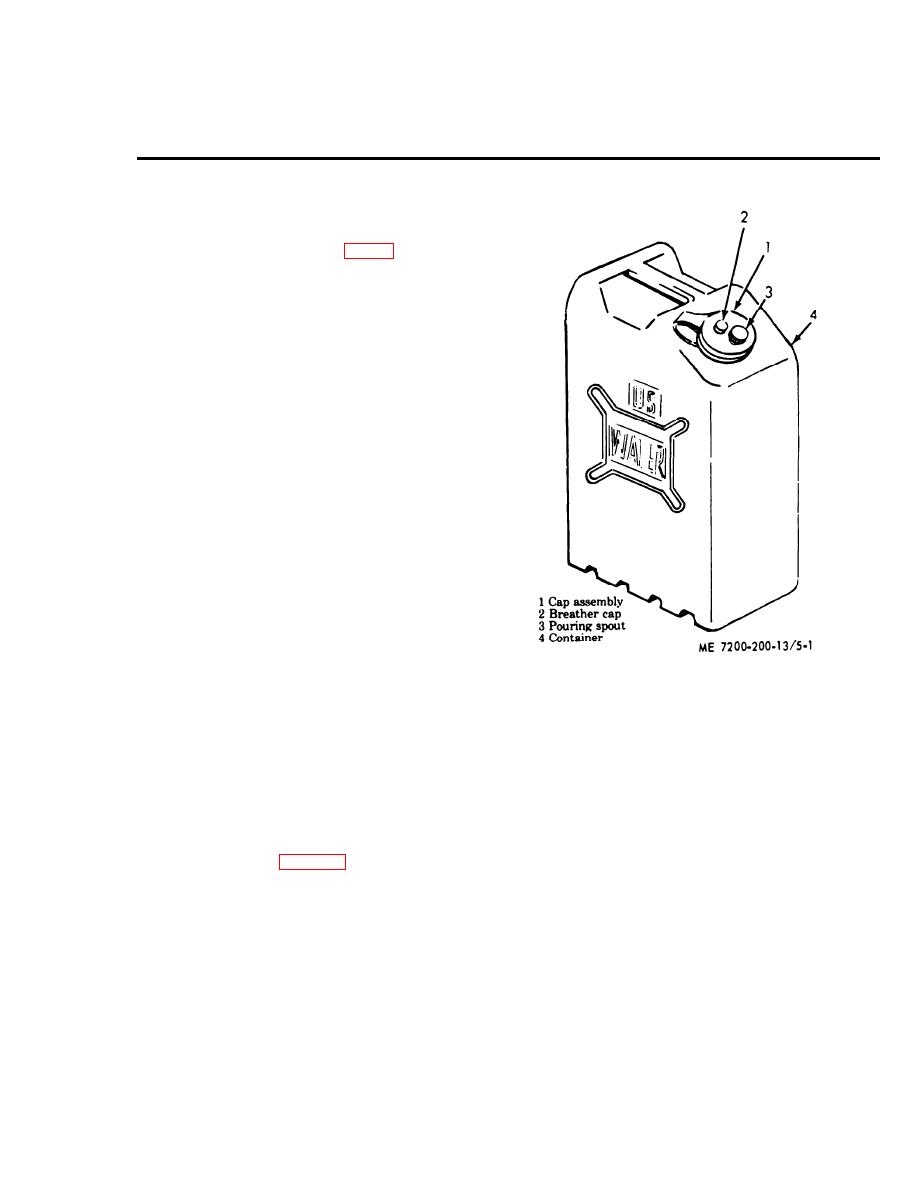 |
|||
|
|
|||
|
Page Title:
CHAPTER 5. CAN, WATER, MILITARY; PLASTIC; 5-GALLON |
|
||
| ||||||||||
|
|
 TM 10-7200-200-13
CHAPTER 5
CAN, WATER, MILITARY; PLASTIC; 5-GALLON
Section I. DESCRIPTION AND TABULATED DATA
5-1. Description
The 5-gallon plastic water can (fig. 5-1) is covered by
specification MIL-C43613 (1). It consists of the body
and the cap. The plastic body is constructed of
highdensity linear virgin polyethylene conforming
to class C, grade 2 of MI L-P-22748, and the
requirements of Federal, Food, Drug, and Cosmetic
Act. The cap assembly is of low density virgin
polyethylene conforming to type III, class L, grade 8
of LP-390, except that the melt index has a
maximum of 4.0 instead of 0.4. The cans are used for
transporting water.
5-2 Tabulated Data
a. Dimensions
Length . . . . . . . . . . . . . . . . . . . . . . . . . . . . . . . . . . . . . . . 13 5/8 inches
Width . . . . . . . . . . . . . . . . . . . . . . . . . . . . . . . . . . . . . . . . 6 7/16 inches
Height . . . . . . . . . . . . . . . . . . . . . . . . . . . . . . . . . . . . . . . 19 inches
b. Capacities.
Liquid . . . . . . . . . . . . . . . . . . . . . . . . . . . . . . . . . . . . . . . 5.05 gal.
Cubage . . . . . . . . . . . . . . . . . . . . . . . . . . . . . . . . . . . . . . . 1 cu. ft.
Figure 5-1. Water can, plastic, 5-gallon.
Section Il. OPERATOR/CREW MAINTENANCE
5-3. Lubrication Instructions
plastic can with a sanitizing chemical, but when it is
required, the chemical must be specified or approved
The five gallon plastic can does not require lubrica-
by the Surgeon General. Use this procedure to clean
tion.
the plastic water can.
5-4. Preventive Maintenance Services
(1) Clean the exterior of cans including the
closure assembly. Use a hot solution of the detergent
The necessary preventive maintenance checks and
compound, P-D410, FSN 7930-2814731, and a cloth,
services to be performed at regularly scheduled
sponge, or fiber brush.
intervals are listed in table 5-1.
(2) Clean the interior of the cans with a hot
5-5. Cleaning, Inspection and Repair
solution of the synthetic detergent P-D-410 at a
concentration of one ounce per gallon, using a cloth,
a. Inspection
sponge, or fiber brush, to reach all areas of the can.
(1) Inspect the cans for cuts, tears, burns, cracks,
Do not use scouring powders, steel wool, metal
and other damage. Make sure the can is free from
sponge, or other abrasive materials which may
leaks.
scratch the surface and make subsequent cleaning
(2) Inspect the interior for cleanliness and for the
difficult.
presence of contamination.
(3) Rinse cans in clear hot water, turn upside
b. Cleaning. Plastic water cans should not be put on
down, and allow to air dry. Water hotter than 180F
a scheduled basis of cleaning, but should be cleaned
may cause the cans to lose shape.
when dirty. There is usually no reason to treat the
Change 1 5-1
|
|
Privacy Statement - Press Release - Copyright Information. - Contact Us |